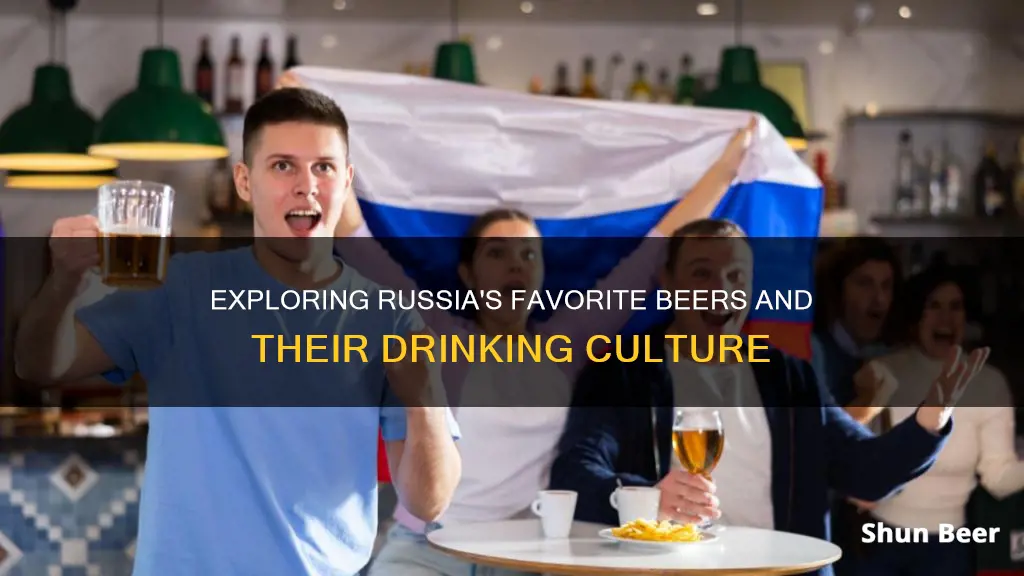
Russia has long been associated with vodka, but beer is actually the second most popular alcoholic drink in the country, with vodka coming in first. In 2010, Russia was the world's fourth-largest beer market. Russians tend to buy beer in cans and PET bottles, and it is often consumed in parks, at sporting events, and during the summer months. The country's beer industry has seen a rise in craft beer, with microbreweries and brewpubs popping up in major cities like St. Petersburg and Moscow.
| Characteristics | Values |
|---|---|
| Beer classification in Russia | Until 2011, beer was not classified as an alcoholic drink in Russia. |
| Beer popularity in Russia | Beer is the second most popular alcoholic beverage in Russia, after vodka. |
| Beer market size | In 2010, Russia was the world's fourth-largest beer market. |
| Beer sales | Over the past decade, beer sales in Russia have risen by more than 40%. |
| Beer producers | In 2011, there were 561 beer producers operating in Russia, including large producers like Baltika and Stary Melnik, as well as microbreweries and restaurant breweries. |
| Beer categorization | Russians categorize beer by color: Light, Red or Semi-Dark, and Dark, rather than by fermentation process or style. |
| Beer consumption patterns | Russians often drink beer in parks, at sporting events, with barbecue, and during the warmer summer months. |
| Beer containers | Russians typically purchase beer in cans and PET bottles, rather than glass bottles. |
What You'll Learn

Beer was classified as a 'foodstuff' in Russia until 2011
In Russia, beer is tied with vodka as the most popular alcoholic drink in the country. Russians categorise beer by colour: Light, Red or Semi-Dark, and Dark. Beer was not classified as an alcoholic drink until 2011, when President Dmitry Medvedev signed a law to this effect. Before this, beer was considered a 'foodstuff' in Russia, and its sale was regulated as such. This was due to an international trade agreement, the Nice Agreement, which distinguished strong alcoholic drinks and beer as two separate classes of goods.
Beer was widely available in Russia prior to 2011, sold in stalls and tents 24 hours a day. It was common to see people drinking beer in public places and on the street. Beer was marketed as a healthier alternative to spirits, and its consumption was rising. Over the decade prior to 2011, beer sales in Russia rose by more than 40%, while vodka sales fell by nearly 30%.
The reclassification of beer as an alcoholic drink in 2011 brought about several changes. People were no longer allowed to drink beer in streets and parks, and sole proprietors could no longer sell beer from stalls and tents. The sale of beer became illegal near educational and sports institutions, as well as bus stops. Advertising was restricted, and stores were no longer allowed to sell beer from 11 pm to 8 am. These measures were introduced to tackle the growing problem of alcohol consumption in Russia, which was already twice the critical level set by the World Health Organization.
Drinking Beer With Theraflu: A Risky Combination
You may want to see also

Russians categorise beer by colour
In Russia, beer (pivo in Russian) is the second most popular alcoholic drink, with vodka taking the top spot. Russians do, however, categorise beer by colour rather than the fermentation process. This means that beer is simply classified as light, red, semi-dark, or dark.
Beer is often the alcoholic beverage of choice for ordinary Russians drinking in parks, at sporting events, with shashlik (barbecue), and during the warmer summer months. Kiosks in parks, train and metro stations, and on the street sell several varieties of lager. It is legal to carry open containers in public in Russia, so it is not uncommon for someone to carry an open beer on their way home from work or to the park.
Until 2011, beer was not classified as an alcoholic drink in Russia. Anything containing less than 10% alcohol was considered a foodstuff, and its sale was regulated as such. This meant that beer was sold in stalls and tents 24 hours a day, and it was common to see people drinking beer in public places and on the street. Beer was even marketed by producers as a healthier alternative to spirits.
In 2011, Russian President Dmitry Medvedev signed a law that reclassified beer as alcohol. This brought about several changes: people were prohibited from drinking beer in streets and parks; sole proprietors selling beer from stalls and tents lost the right to do so; the sale of beer became illegal in the vicinity of children’s educational and sports institutions (such as schools and kindergartens) and near bus stops; outdoor and TV advertising was restricted; and stores lost the right to sell beer from 11 pm to 8 am.
These measures were aimed at combatting growing alcohol consumption in Russia, which has been a pervasive and socially acceptable behaviour in Russian society for centuries.
Wisconsin Kids Drinking Beer: Consent and the Law
You may want to see also

Baltika Brewery is Russia's biggest beer producer
In Russia, beer is tied with vodka as the country's most popular alcoholic drink. Baltika Brewery is the biggest beer producer in Russia, with over 38% market share. It is also the second-largest brewing company in Europe. Headquartered in St. Petersburg, the company was founded in 1990 and has been the market leader in Russia since 1996.
Baltika Brewery is part of the Carlsberg Group, one of the leading brewery groups in the world. It has eight breweries across Russia, with a total capacity of approximately 40 million hectolitres of beer per year. The company employs about 8,300 to 8,500 people and produces a wide range of beers, including pale and dark lagers, alcoholic-free and stout varieties, and international brands such as Tuborg, Holsten, and Carlsberg.
Baltika's products are sold in 98% of retail outlets in Russia, and the company has a strong presence in the export market as well. In 2012, Baltika's products were represented in more than 75 countries worldwide, including Western Europe, North America, and the Asia-Pacific region. The company has continued to expand its international reach, shipping a batch of beer to Honduras in 2018.
Baltika Brewery has a diverse portfolio of brands, including over 30 beer brands and several non-beer brands. The company's main source of awards and recognition comes from its consumers, who prefer Baltika's beers to other brands. In addition to its market leadership, Baltika has also been recognised for its innovation and quality, winning awards in more than 670 international and national competitions.
Despite challenges in recent years, such as the COVID-19 pandemic and changes in consumer behaviour, Baltika Brewery has demonstrated its adaptability and resilience. In the first nine months of 2021, the company surpassed its 2020 volumes and increased its sales by 5% year-over-year. Baltika's success and longevity in the highly competitive Russian beer market are a testament to its strong brand and effective business strategies.
Enjoying a Beer: Porch Drinking Laws and You
You may want to see also

Kvass is a traditional fermented Russian beer
In modern times, kvass is usually quite low in alcohol content and is considered more of a soft drink, similar to soda, and is even suitable for children. It is sold in bottles or cans and is also available from street vendors during the summer months. It is typically served unfiltered, with yeast still in the bottle or can, as this is thought to have nutritional benefits.
Kvass has been a particularly popular drink during certain periods of Russian history, such as during the reign of Peter the Great, who ruled the Russian Empire from 1682 to 1725. Today, Ochakovo Company is the leading producer of kvass in Russia, and other popular brands include Nikola Kvass, produced by the Deka beverage company.
While Russia has experienced a rise in the popularity of modern lagers and craft beers, kvass remains an important part of Russia's drinking culture and is a unique, traditional beverage with a long history.
Old Beer: Safe to Drink After a Decade?
You may want to see also

Beer is the second most popular alcoholic drink in Russia
Beer, or 'pivo' in Russian, is the second most popular alcoholic drink in Russia, with vodka taking the top spot. Russians tend to favour beer over wine. In 2010, Russia was the world's fourth-largest beer market.
Beer consumption in Russia has been steadily rising, with beer sales increasing by over 40% in the decade leading up to 2011. In contrast, vodka sales have been declining, dropping by nearly 30% in the same period. This shift in drinking preferences has led to beer becoming a significant contributor to the overall alcohol consumption in the country.
The popularity of beer in Russia can be attributed to several factors. One reason is its accessibility and affordability compared to other alcoholic beverages. Before 2011, beer was not classified as an alcoholic drink in Russia due to its low alcohol content, typically containing less than 10% alcohol. This classification as a 'foodstuff' meant that beer was widely available, sold around the clock in stalls, tents, and kiosks, and consumed in public spaces. It was marketed as a healthier alternative to spirits and was not subject to the same regulations as stronger alcoholic drinks.
However, in 2011, a significant change occurred when President Dmitry Medvedev signed a law officially recognising beer as an alcoholic beverage. This reclassification brought about stricter regulations, including restrictions on advertising and sales. Beer could no longer be sold in unlicensed kiosks or during certain hours, and consumption in public spaces like streets and parks became prohibited. These measures were implemented to address the growing problem of alcohol abuse in Russia, which has had serious negative social, political, economic, and public health consequences.
Despite these efforts, beer remains a popular alcoholic beverage in Russia, and the country has a thriving brewing industry. The market is dominated by large breweries such as Baltika, which is now part of the Carlsberg Group, as well as smaller microbreweries and brewpubs, particularly in cities like St. Petersburg and Moscow.
Beer Drinking Culture in the Dominican Republic
You may want to see also
Frequently asked questions
Russians tend to drink lagers, with pale lagers being the most common. The Baltika Brewery is the country's largest brewing company, producing 14 different beers, all lagers, including a non-alcoholic pale lager and several dark lagers. Baltika also offers beer-mix coolers such as Baltika Kuler and Baltika Kuler Lime.
Until 2011, anything containing less than 10% alcohol was classified as food in Russia, and its sale was not regulated in the same way as stronger alcoholic drinks. However, in 2011, then-President Dmitry Medvedev signed a law that reclassified beer as alcohol, bringing it under the same controls as spirits.
Vodka has long been the traditional alcoholic drink in Russia, but beer has become increasingly popular, marketed as a healthier alternative to spirits. Russians also drink cocktails such as the White Russian, which is made with vodka, coffee liqueur, cream, and ice.







